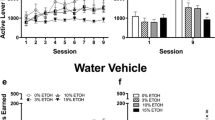Abstract
Rationale: For the purpose of investigating the determinants of preference for alcohol, it would be advantageous to use a procedure in which the subjects had concurrent access to alcohol and an isocaloric food. However, in widely used animal models, the introduction of a weak sucrose solution markedly reduced alcohol consumption. In contrast, when alcohol was sweetened, rats defended high baseline levels of alcohol intake despite access to chow, 10% sucrose, and increases in body weight that markedly reduced food consumption. Under these conditions, certain pharmacological treatments selectively reduced alcohol consumption. The present experiment further tests the generality of the contrast between food and sweetened alcohol consumption in rats. Objective: To test if rats will defend baseline levels of alcohol consumption when (1) the competing reinforcer is an isocaloric, preferred food and (2) when the cost of defending alcohol entails a decrease in food consumption as well as an increase in response output. Methods: The rats had access to a 10% alcohol plus 0.25% saccharin solution and an isocaloric, 14.8% Polycose solution in a two-lever, choice procedure. In the initial condition, the response requirement for each drink was set at five responses (variable-ratio 5); in subsequent conditions the variable-ratio values were increased to 7.5, 10, 15, and 30 responses. Results: In the initial condition, the rats drank twice as much Polycose as alcohol. However, with increases in the variable-ratio requirements, Polycose consumption systematically decreased, whereas sweetened alcohol consumption remained at its baseline level or above in all but the variable-ratio 30 condition. Conclusions: Rats defended baseline alcohol consumption but not baseline food consumption. As alcohol and food consumption can be dissociated in humans, research on the mechanisms that mediate alcohol regulated preference in rats may shed light on the mechanisms that control human alcohol consumption.
Similar content being viewed by others
Author information
Authors and Affiliations
Additional information
Received: 17 June 1998 / Final version: 9 January 1999
Rights and permissions
About this article
Cite this article
Heyman, G., Gendel, K. & Goodman, J. Inelastic demand for alcohol in rats. Psychopharmacology 144, 213–219 (1999). https://doi.org/10.1007/s002130050996
Issue Date:
DOI: https://doi.org/10.1007/s002130050996




